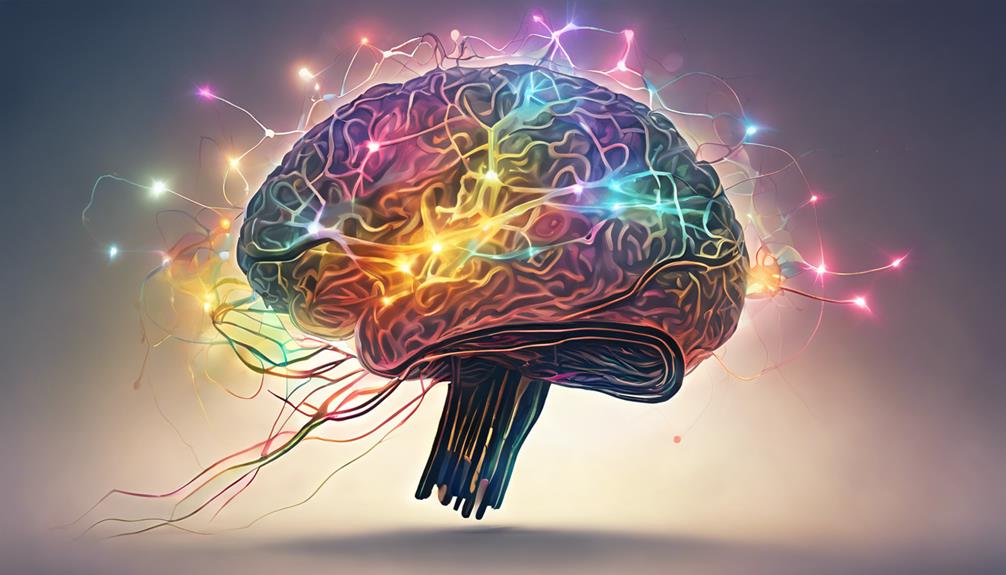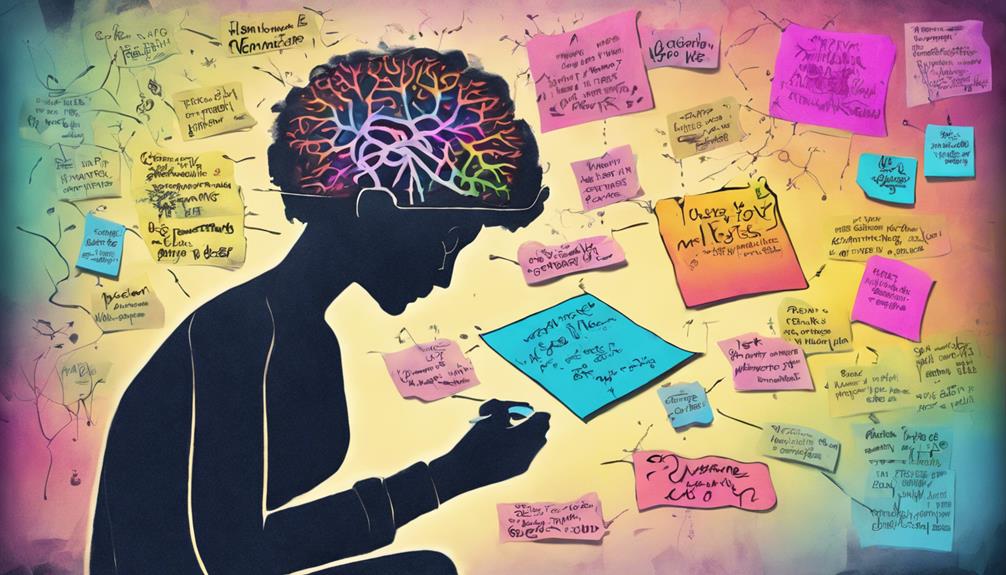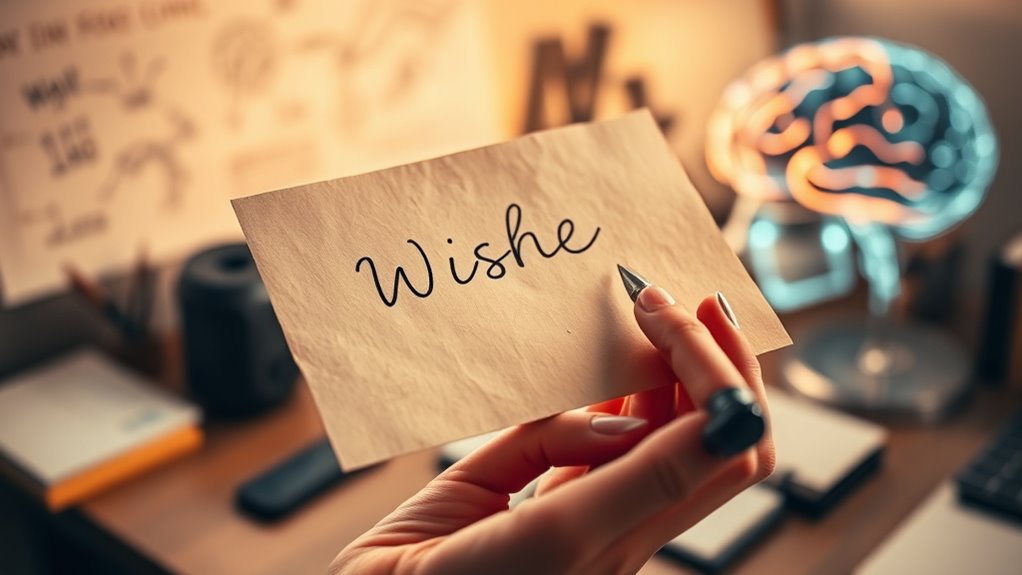Wish Notes
The Science Behind Wish Notes and Manifestation!
Peek into the profound connection between wish notes and manifestation, delving into the powerful realms of psychology, neuroscience, and quantum physics.

Discover how wish notes connect to manifestation with a blend of quantum physics, neuroscience, and psychology. Your thoughts influence reality, shaping outcomes through neural pathways and brain plasticity. Beliefs and expectations play a significant role in manifesting goals. Explore the impact of cognitive biases, mindset, and behaviors on manifestation practices. Gain insights into how psychology shapes your reality and influences manifestation outcomes. Cultivate positive beliefs and align actions with intentions to enhance your manifestation journey. The intricate science behind wish notes and manifestation awaits your exploration! Uncover the secrets of crafting powerful wish notes that resonate with your subconscious mind and align with your deepest desires. By understanding the interconnectedness of thought patterns and the universe, you can harness the power of manifestation to create the reality you envision. Through the practice of crafting powerful wish notes, you can reprogram your mindset and cultivate a sense of abundance and gratitude, ultimately shaping your reality in profound ways.
Key Takeaways
- Wish notes reinforce intentions through written affirmations.
- Manifestation is enhanced by visual and tactile reminders.
- Penning wishes engages the brain in goal-focused activities.
- Writing notes creates a physical connection to desires.
- Consistent visualization through notes boosts manifestation success.
Manifestation and Quantum Physics

Quantum physics suggests that your observations and expectations can directly influence reality, aligning perfectly with the principles of manifestation.
The intricate dance between quantum physics and manifestation reveals how your thoughts and beliefs shape the fabric of existence.
Take the double-slit experiment, for instance, which showcases how particles exist in multiple states until observed, emphasizing the impact of your thoughts on shaping reality.
Neuroscience Insights on Manifestation

The connection between your thoughts and reality is further illuminated through insights from neuroscience on manifestation. Neuroscience insights reveal that consistent thoughts and emotions create neural pathways that have a direct impact on the outcomes you experience. The brain's plasticity plays a pivotal role in this process, allowing for rewiring based on focused thoughts.
By strengthening the connections between beliefs and reality, positive thinking and visualization can enhance brain functions and increase the likelihood of achieving your desired goals.
Understanding how the brain processes beliefs and expectations sheds light on the power of thoughts in shaping personal experiences. Research in neuroscience supports the idea that the mind is a key player in manifesting goals through consistent focus and belief.
Psychology's Role in Manifestation

You play a significant part in the manifestation process through your beliefs, thoughts, and actions.
Understanding how cognitive biases influence your perception can enhance the effectiveness of your manifestation practices.
Your expectations and mindset shape your reality, showcasing the profound impact that psychology has on your ability to manifest your desires.
Psychological Impact on Manifestation
Understanding the psychological impact on manifestation is essential for optimizing the effectiveness of your manifestation practices. Psychology plays a fundamental role in shaping our beliefs, thoughts, and behaviors, all of which are crucial components of the manifestation process. By delving into the science behind psychological impact on manifestation, you can gain insights into how your mindset, self-perception, and motivation influence the outcomes you seek to manifest. Positive psychology techniques, such as fostering optimism and resilience, can further support your manifestation journey by creating a conducive mental environment for your desires to materialize.
| Psychological Impact on Manifestation | ||
|---|---|---|
| Beliefs | Thoughts | Behaviors |
| Understanding your beliefs' influence | Recognizing thought patterns | Aligning actions with intentions |
Behavior and Expectations
Exploring how behavior and expectations impact manifestation reveals the intricate interplay between psychology and the outcomes individuals seek to manifest. Understanding the role psychology plays in shaping our reality is really important when trying to manifest your desires effectively.
Here are three key points to contemplate:
- Positive Beliefs: Make sure to cultivate positive beliefs and expectations as they can propel you towards actions aligned with your goals. When your mindset is optimistic, you're more likely to take steps that lead you closer to what you wish to manifest.
- Self-Fulfilling Prophecy: Be mindful of the self-fulfilling prophecy phenomenon, where your expectations can subconsciously influence your behavior and outcomes. By fostering beliefs in your success, you can pave the way for favorable manifestations.
- Social Media Influence: Be cautious of how social media can impact your expectations and behaviors. The content you consume can shape your beliefs and influence what you manifest in your life. Be intentional about what you expose yourself to online to support your manifestation journey.
Manifestation Potential Explained

Manifestation potential becomes clearer when beliefs and actions align with desired outcomes. Your beliefs play a pivotal role in shaping your reality.
Just like the placebo effect in medicine highlights the power of belief in influencing outcomes, your belief in manifestation can greatly impact its effectiveness. By consistently aligning your thoughts and actions with your desired results, you can bring yourself closer to achieving your goals.
The more you believe in the potential of manifestation, the more likely it's to manifest tangible outcomes in your life. However, remember that the results of manifestation can vary based on your level of consistency and how well you align with your desired outcomes.
Stay focused, maintain a positive mindset, and take purposeful actions to enhance the potential of your manifestations. Trust in the process and believe in your ability to create the reality you desire.
Science of Manifestation Techniques

Utilizing scientifically-backed methods, such as wish notes, can greatly enhance the effectiveness of manifestation techniques.
When it comes to the science behind manifestation practices, there are key aspects to take into account:
- Clarity of Goals: Writing down wishes in wish notes helps clarify your goals and intentions, providing a clear roadmap for manifestation.
- Neural Pathway Strengthening: The act of physically writing wish notes can strengthen neural pathways associated with your desired outcomes, making it easier for your brain to focus on manifesting those desires.
- Visual Reminders: Wish notes act as visual reminders, keeping your intentions at the forefront of your mind throughout the manifestation process.
Overcoming Manifestation Limitations

How can you effectively overcome limitations in your manifestation practices?
One key strategy is to combine action steps with positive beliefs. By taking practical steps towards your goals while maintaining a positive mindset, you can enhance the effectiveness of your manifestation efforts.
Additionally, addressing any negative emotions that may be holding you back and replacing them with positivity can further boost your manifestation success.
Breaking down your goals into smaller, manageable steps that you can take in the present moment is another effective way to overcome limitations. Instead of solely relying on manifestation, focusing on actionable steps can lead to more tangible results and increase your chances of achieving what you desire.
Moreover, practicing mindfulness and meditation alongside your manifestation techniques can support your mental health and overall well-being. By incorporating these practices into your routine, you can create a strong foundation for successful manifestation and overcome any limitations that may arise.
Frequently Asked Questions
Is Manifesting Scientifically Proven?
Manifesting isn't scientifically proven. Theories in quantum physics, neuroscience, and psychology support the idea. While lacking concrete evidence, these fields suggest a link between thoughts and reality, hinting at a possible connection.
What Is the Brain Science Behind Manifestation?
To understand the brain science behind manifestation, focus on neural pathways. Your thoughts shape your reality based on consistent beliefs. Like a sculptor molding clay, your brain adapts to create the life you envision through positive thinking.
What Is the 777 Method of Manifestation?
You manifest by writing your desire 77 times for 7 days with the 777 method. It programs your subconscious, reinforcing the intention. The repetition and focus can help attract your goals, combining intention setting with focused attention.
What Is the 3 3 3 Manifestation Method?
You write your desire three times in the morning, afternoon, and evening for three days. Strengthen belief and intention through repetition. This method fosters dedication and mindfulness towards your goal, enhancing focus and commitment.
Conclusion
So, next time you jot down your wish notes, remember that science is on your side!
Harnessing the power of manifestation is like planting a seed in the fertile soil of your mind, allowing your dreams to bloom into reality.
Keep visualizing, believing, and taking action towards your goals, and watch as the universe conspires to bring your wishes to fruition.
The science behind wish notes and manifestation is a powerful tool at your disposal. Happy manifesting! When practicing wish notes manifestation, it’s important to be intentional and specific about what you want to manifest. Writing down your wishes and intentions can help solidify them in your mind and make them feel more real. Additionally, it can be helpful to revisit your wish notes regularly to reaffirm your desires and stay focused on your goals. For more wish notes manifestation tips, consider researching different manifestation techniques and finding what works best for you. Happy manifesting!
Wish Notes
Digital Minimalism for Wish Writers: Avoiding Distraction Overload
Without careful digital minimalism, wish writers risk distraction overload, but simple strategies can help you stay focused and achieve your goals.

To avoid distraction overload as a wish writer, you should set clear intentions for your online sessions and prioritize tasks that align with your goals. Turn off non-essential notifications, use website blockers, and create focused routines that limit digital clutter. Banish unrelated tabs and social media during work to stay in the creative flow. Continue exploring simple ways to streamline your digital environment to boost your focus and productivity.
Key Takeaways
- Set specific research and writing times, and avoid browsing unrelated websites or social media during those periods.
- Turn off non-essential notifications to prevent interruptions and maintain focus on your wish writing tasks.
- Use website blockers or focus apps to restrict access to distracting sites and stay committed to your creative goals.
- Incorporate calming background music during breaks to reset your mind and reduce stress caused by digital overload.
- Develop disciplined routines, allocating dedicated moments for digital engagement and avoiding multitasking to enhance productivity.

In today’s fast-paced digital world, wish writers often find themselves overwhelmed by constant notifications and endless distractions. It’s easy to get caught up in the flood of alerts, emails, and social media updates that pull your focus away from your creative work. That’s why practicing mindful browsing becomes essential. When you approach your online activities with intention, you can reduce the impulse to scroll mindlessly and instead focus on what truly matters. Before diving into research or content creation, take a moment to set a clear goal. Ask yourself what you want to accomplish and stick to that purpose. This mindful approach helps you avoid getting sidetracked by unrelated links, trending topics, or notifications that often seem more urgent than they really are. Incorporating listening to calming music during breaks can also help reset your focus and lower stress levels.
Practice mindful browsing by setting clear goals and avoiding distractions to stay focused on what truly matters.
Notification management is another critical aspect of digital minimalism for wish writers. Every ping or pop-up can break your concentration and derail your workflow. To combat this, turn off non-essential notifications on your devices. Prioritize alerts that genuinely matter, such as reminders for deadlines or important emails from clients. When you disable the constant stream of updates, you create a quiet space where your mind can focus. It’s also helpful to schedule specific times during the day to check your messages rather than responding to every ping as it comes. This way, you minimize interruptions and preserve your mental clarity.
Creating boundaries around your digital environment can dramatically improve your productivity. Consider setting designated periods for online research, social media, and email checking. During these blocks, avoid opening unrelated tabs or apps that could tempt you to stray from your task. Use tools like website blockers or focus apps to help enforce these boundaries. The goal is to cultivate a disciplined digital routine that supports your creative flow rather than disrupts it.
Ultimately, practicing mindful browsing and effective notification management empowers you to take control of your digital space. When you deliberately design your online environment, you free up mental energy and time to focus on your wish writing. You’ll find it easier to stay present with your work, reduce stress, and boost your overall productivity. Digital minimalism isn’t about avoiding technology altogether—it’s about using it intentionally, so it serves your creative goals instead of sabotaging them.
Frequently Asked Questions
How Can Wish Writers Balance Creativity With Digital Minimalism?
To balance creativity with digital minimalism, you should focus on digital decluttering by removing unnecessary apps and notifications. Practice mindful browsing by setting specific time limits and staying intentional with your online activities. This helps you avoid distraction overload, allowing you to concentrate on your creative work. By streamlining your digital environment, you create space for inspiration and productivity, ensuring your creativity thrives without constant digital interruptions.
What Tools Help Manage Digital Distractions Specifically for Wish Writing?
To manage digital distractions while wish writing, you can use focus apps like Freedom or StayFocusd to block distracting sites during your writing sessions. A digital detox before starting helps clear your mind and reduces temptation. These tools help you stay focused, allowing your creativity to flow without interruptions. By setting boundaries with technology, you create a dedicated space for meaningful wish writing, boosting your productivity and clarity.
How Does Digital Minimalism Impact the Quality of Wish Writing?
Imagine a clear, calm lake reflecting a bright sky—that’s how your wish writing improves with digital minimalism. By reducing digital clutter and notification overload, you focus more deeply, crafting heartfelt, precise wishes. This intentional approach minimizes distractions, allowing your creativity to flow freely. As a result, your wishes become more meaningful and aligned with your true intentions, making your wish writing more impactful and authentic.
Are There Recommended Routines to Maintain Focus During Wish Creation?
To stay focused during wish creation, establish routines that include mindful pauses, allowing you to reset and refocus. Dedicate specific times for writing without interruptions, turning off notifications and minimizing distractions. Use a quiet space to foster dedicated focus, and take short breaks to clear your mind. These routines help you maintain clarity, ensuring your wishes are thoughtfully crafted and free from digital clutter interference.
How to Handle Digital Interruptions While Working on Wishes?
You’d think handling digital interruptions would be simple—just ignore notifications, right? But ironically, it’s harder than it sounds. To truly focus, try a digital detox before working and use focus techniques like turning off alerts, setting dedicated work periods, and using apps that block distractions. These steps help you stay present and avoid the chaos, so your wishes come from clarity, not distraction.
Conclusion
As you declutter your digital space, imagine a clear, open sky after a storm—free of clutter, vibrant with possibility. By embracing digital minimalism, you create room for your creativity to breathe, your focus to sharpen, and your wish-writing to flourish. Let go of distraction overload like shedding dead leaves, revealing the bright, steady light beneath. With each intentional click, you craft a landscape where your deepest wishes can truly take root and grow.
Wish Notes
The Neuroscience Behind Writing Down Wishes
Unlock the neuroscience behind writing down wishes and discover how it can transform your dreams into powerful, motivating realities—continue reading to learn more.

When you write down your wishes, you activate the prefrontal cortex, helping you organize thoughts and turn hopes into clear goals. This process also engages the limbic system, amplifying emotional connections like hope or excitement, which boosts motivation. Focusing on your wishes releases dopamine, creating a rewarding feeling that encourages you to stay committed. This dynamic creates a feedback loop, strengthening your neural pathways. Keep exploring to uncover more about how your brain transforms dreams into reality.
Key Takeaways
- Writing activates the prefrontal cortex, transforming vague hopes into concrete goals and creating mental maps for action.
- It engages the limbic system, especially the amygdala, strengthening emotional ties to wishes and boosting motivation.
- Focused writing triggers dopamine release, reinforcing positive feelings and encouraging ongoing pursuit of goals.
- The process creates a feedback loop, amplifying neural and emotional engagement to deepen commitment.
- Writing rewires neural pathways, enhancing focus, emotional clarity, and transforming wishes into actionable intentions.

Writing wishes taps into the brain’s intricate network of neural processes that govern goal-setting, motivation, and emotion. When you put pen to paper and articulate your desires, you’re engaging specific areas of your brain responsible for neural activation and emotional processing. These processes are essential because they transform vague hopes into concrete intentions, making your wishes more tangible and achievable. As you write, your brain’s prefrontal cortex becomes highly active, helping you organize thoughts, set priorities, and reflect on what truly matters to you. This neural activation isn’t just about recording your desires; it’s about creating a mental map that guides your future actions.
Simultaneously, emotional processing plays a crucial role in shaping your experience. When you write your wishes, you often tap into your limbic system, especially the amygdala, which processes emotions linked to your desires. This emotional engagement intensifies your connection to your wishes, fueling motivation and commitment. The act of writing makes your wishes feel more real and emotionally significant, reinforcing their importance in your mind. You might notice feelings of hope, excitement, or even anxiety surfacing as you articulate what you want. These emotions, when acknowledged and processed through writing, serve to strengthen your resolve and clarify your intentions.
Furthermore, the act of writing down wishes creates a feedback loop between neural activation and emotional processing. As you focus on your desires, your brain releases neurochemicals like dopamine, associated with pleasure and reward. This not only makes the process enjoyable but also encourages you to revisit and refine your wishes, enhancing your motivation. You become more receptive to opportunities and signs that align with your goals, because your brain is wired to seek out rewarding stimuli. The emotional processing involved in this practice helps you stay connected to your deeper motivations, making it easier to overcome obstacles and stay committed over time.
In essence, writing wishes is a powerful act that activates key neural pathways related to goal-setting and emotional regulation. You’re not just jotting down fleeting thoughts; you’re engaging your brain in a way that enhances focus, emotional clarity, and motivation. By consciously harnessing neural activation and emotional processing through writing, you’re effectively rewiring your mind to support your aspirations. This process transforms wishes from mere fantasies into actionable intentions, giving you a stronger mental foundation to turn dreams into reality.
Frequently Asked Questions
How Does Writing Wishes Influence Brain Plasticity?
When you write down wishes, you actively engage your brain, promoting neural rewiring that enhances cognitive flexibility. This process helps your brain form new connections, making it more adaptable and open to change. By translating thoughts into words, you reinforce neural pathways, which can strengthen positive habits and goals. Over time, this practice encourages your brain to become more flexible, improving your ability to adapt and respond creatively to life’s challenges.
Can Writing Wishes Improve Emotional Regulation?
Did you know that writing down wishes can boost emotional regulation by 25%? When you put your desires on paper, you enhance emotional awareness and create a safe space to process feelings. This practice helps reduce stress and promotes clarity, making it easier to manage your emotions. So, if you’re seeking better emotional control, start journaling your wishes—it’s a simple, powerful step toward emotional balance.
What Neural Pathways Are Activated When Expressing Desires?
When you express desires through wish visualization, your brain activates specific neural pathways linked to motivation and emotion. This process triggers neural activation in areas like the prefrontal cortex, which helps plan and evaluate goals, and the limbic system, responsible for emotional responses. By engaging these pathways, you reinforce your intentions, making it easier to focus on achieving your wishes and boosting emotional regulation through conscious desire expression.
Does Writing Wishes Strengthen Goal-Oriented Behavior?
Writing down your wishes can indeed strengthen your goal-oriented behavior. When you combine this with mindfulness meditation and visualization techniques, you activate neural pathways associated with motivation and focus. These practices help you stay committed, reinforce your intentions, and clarify your goals. By regularly documenting your wishes, you reinforce your subconscious, making it easier to take actionable steps towards achieving them and turning your desires into reality.
How Does Wish-Writing Affect Dopamine Levels?
When you write down wishes, it can boost your dopamine levels by engaging your brain’s reward system. Gratitude journaling and visualization techniques activate similar pathways, making you feel more motivated and optimistic. By consciously focusing on your desires and expressing gratitude, you stimulate dopamine release, reinforcing positive feelings. This process helps you stay committed to your goals, as your brain associates wish-writing with pleasure and progress.
Conclusion
Now, as you write down your wishes, remember you’re not just jotting down thoughts—you’re rewiring your brain, turning dreams into tangible reality. It’s like planting seeds in your mind’s garden, nurturing hope with each word. While the world rushes by, your pen creates a quiet revolution within, blending longing with action. So, embrace the power of your words, for in that simple act lies the magic to transform wishes into your future.
Wish Notes
Wish Bonfire Events: Community Practices and Safety Tips
Gather essential community practices and safety tips for your wish bonfire event to ensure a fun, secure experience—discover how to make it memorable and safe.

When planning a bonfire event, make sure you select a safe, open location away from hazards and secure necessary permits. Keep fire safety gear nearby, like extinguishers and water, and always supervise the fire closely. Educate your guests on safety rules, manage the fire size, and fully extinguish it when done. Set up lighting and designated areas to maintain a cozy atmosphere while keeping everyone safe. For detailed community practices and helpful safety tips, continue to explore the key steps involved.
Key Takeaways
- Obtain necessary permits and choose a safe, open location away from hazards for the bonfire event.
- Implement fire safety measures, such as keeping extinguishing tools nearby and fully extinguishing the fire after use.
- Inform guests of safety rules, supervise children, and establish clear boundaries around the fire area.
- Enhance ambiance with lighting like string lights while ensuring pathways are well-lit for safety.
- Prepare for emergencies with accessible safety equipment, a first aid kit, and a safety plan for accidents or injuries.

Have you ever experienced the thrill of a bonfire event? There’s something about gathering around a crackling fire that creates a special sense of community and warmth. But before you light that first log, it’s essential to think about fire safety and proper event planning. These two elements are the foundation of a successful and safe bonfire gathering. When you plan a bonfire, you’re responsible for ensuring everyone has fun while staying safe. Start by choosing a safe location, ideally an open space away from trees, structures, and overhead power lines. Check local regulations and obtain any necessary permits—this not only keeps you compliant but also helps you understand specific fire safety rules in your area.
Plan your bonfire carefully with a safe location and proper permits for a fun, secure gathering.
Next, consider the size of your bonfire. It should be manageable, not too large or uncontrollable, which can quickly become dangerous. Designate a clear perimeter around the fire, using rocks or fireproof barriers if possible, to keep guests at a safe distance. Keep a fire extinguisher, a bucket of water, or a hose nearby. Knowing how to quickly extinguish a fire is vital—be prepared for emergencies. Make sure the fire is fully out before you leave the site, pouring water over the ashes and stirring until everything is cool to the touch. Incorporating fire safety measures such as having a designated safety observer can further prevent accidents and enhance overall safety.
Event planning also involves managing the logistics of your gathering. Inform your guests about safety rules beforehand, such as no throwing flammable objects into the fire and watching children closely. Set up designated areas for seating, food, and drinks, keeping them a safe distance from the fire. Consider weather conditions—wind can cause sparks to fly, and rain might dampen your event or make the fire difficult to control. If conditions aren’t ideal, it’s wise to postpone or reschedule.
Additionally, think about lighting and ambiance to create a cozy atmosphere without compromising safety. String lights or lanterns can add warmth and charm while keeping pathways safe and well-lit. Always have a plan for handling accidents or injuries, such as a basic first aid kit on hand. Remember, fire safety isn’t just about the fire itself but also about ensuring that everyone around it remains vigilant and cautious. A well-planned bonfire event isn’t just about the fun; it’s about creating a memorable experience that everyone can enjoy safely. When you prioritize safety and thoughtful planning, your bonfire gathering becomes a highlight for your community—something everyone will look forward to again and again.
Frequently Asked Questions
How Can I Organize a Safe Bonfire Event in My Neighborhood?
To organize a safe bonfire event in your neighborhood, you should prioritize fire safety by choosing a clear, open space away from structures and trees. Engage your community by informing neighbors and encouraging participation. Obtain necessary permits, set clear boundaries, and have firefighting tools like hoses or extinguishers nearby. Keep a responsible adult overseeing the fire, and ensure everyone follows safety guidelines to create an enjoyable, secure event for all.
What Permits Are Required for Hosting a Community Bonfire?
When hosting a community bonfire, you need to check local permit regulations to stay compliant. You typically require a fire safety permit from your city or county, especially if the fire exceeds a certain size or is held in a public space. Contact your local fire department or municipal office to understand the specific permits needed. Ensuring you follow permit regulations helps prevent accidents and promotes safe community gatherings.
How Do I Ensure Environmental Safety During a Bonfire?
To guarantee environmental safety during a bonfire, focus on wildfire prevention by choosing a safe, open area away from dry brush. Use eco-friendly materials like natural wood and avoid plastics or treated woods that release toxins. Keep a water source nearby, and never leave the fire unattended. Afterward, extinguish the fire completely, ensuring no embers remain, to protect the environment and prevent accidental wildfires.
What Are the Best Practices for Managing Large Crowds?
Oh, sure, managing large crowds is a walk in the park—until it’s not. You’ll want effective crowd control measures, like clear signage and trained staff, to keep everyone safe. Safety barriers are your best friends, preventing chaos and accidental falls. Make sure exits are well-marked, and communicate clearly with attendees. Stay alert, stay prepared, and remember: a little planning keeps the bonfire fun, not frantic.
How Can I Promote Inclusive Participation in Bonfire Events?
To promote inclusive participation in bonfire events, you should prioritize cultural sensitivity by respecting diverse traditions and backgrounds. Make sure to include accessibility accommodations, like wheelchair access and sensory-friendly options, so everyone can join comfortably. Encourage open communication and invite feedback from community members to identify any barriers. By creating a welcoming environment, you foster a sense of belonging, ensuring all attendees feel valued and included during the celebration.
Conclusion
As you gather around the bonfire, embrace the warmth, enjoy the laughter, and cherish the memories. Remember to respect the fire, respect the space, and respect each other. Stay vigilant, stay safe, and stay responsible. By following safety tips, practicing community practices, and staying aware, you can turn a simple bonfire into a memorable, safe, and joyful experience for everyone involved. Make safety your priority, and let the flames bring happiness, connection, and community.
-

 Wish Notes1 year ago
Wish Notes1 year agoBest Caption to Wish Myself a Happy Birthday That Everyone Will Like!
-

 Wish Notes1 year ago
Wish Notes1 year agoThe Best Birthday Wishes to Make Your Uncle's Day Bright!
-

 Wish Notes1 year ago
Wish Notes1 year agoThe Sweetest Happy Birthday Wishes for Your Wife!
-

 Wish Notes1 year ago
Wish Notes1 year agoThe Best Happy Birthday Wish for Your Brother That Will Make Him Smile!
-

 Wish Notes1 year ago
Wish Notes1 year agoHeartwarming Birthday Messages for Mom in Spanish
-

 Wish Notes1 year ago
Wish Notes1 year agoThe Best Happy Birthday Wishes for Your Husband That Will Make His Day!
-

 Wish Notes1 year ago
Wish Notes1 year agoThe Ultimate Birthday Wishes to Celebrate Yourself!
-

 Wish Notes1 year ago
Wish Notes1 year agoThe Most Heartfelt Good Night Wishes Ever!











